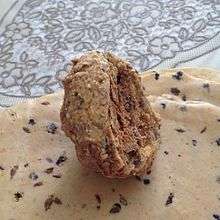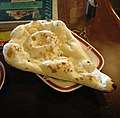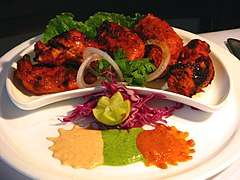Amritsari Papar Warian
Amritsari Papad or papar is a variety of the papad snack [1] specific to the north Indian state of Punjab and the surrounding region, and even more specific to the city of Amritsar. Amritsari papad is famous throughout India, and is also exported abroad.

Like papad elsewhere in India, Amritsari papad is made from seasoned dough, usually of hulled urad daal flour, seasoned liberally with salt, black pepper, heeng (asafoetida), cumin, coriander, pomegranate seeds, and sometimes garlic. The proportions are highly variable, leading to a large variety in taste and pungency. The dough is rolled into wafer thin discs the size of a small plate, and sun-dried to prepare raw papad. Flours from other sources such as lentils, chickpeas, rice, tapioca or potato, are sometimes used. Dried papad will keep for several months without refrigeration. Although now done by machines, papad was traditionally rolled out by hand, requiring a fair amount of force because of the dryness of the dough -- indeed, In Hindi and Punjabi, "papad belna" (rolling out papad) is still a metaphor for any laborious or arduous task.
Papad is prepared by roasting in an oven or on an open flame, and because it is so thin and dry, takes but a fraction of a minute to be done. In Punjab, it is typically served as an accompaniment to a meal after roasting in an oven or on an open flame, but elsewhere in India it is also eaten as an appetizer or snack, with toppings such as chopped onions, carrots, chutney or other dips and condiments. Papad is a low calorie food but has a high sodium content.[2]
Amritsari Vadiyan
Amritsari Vadi (plural: vadiyan) is also made similarly from dough prepared from a paste of ground urad dal, with salt, black pepper, heeng, red chili, coriander seeds, salt, cumin seeds etc. added to it. Paste is shaped by hand into half round 5 cm balls, and spread out on sheets for sun-drying. Like papad, dried vadis can be kept for months. Dried vadis are cracked into bite sized pieces and added to curries and vegetable dishes. These give the dishes a smoky and piquant taste.

Until recently, the traditional papad and vadiyan makers of Amritsar were concentrated in a famous street known as the Papad Vadiyan Bazaar near the Golden Temple. The Bazaar was suffused with the pungent aroma of the spices used to make papad and wadiyan, and visitors to the bazaar often remembered the smell as an unforgettable experience. After the implementation of the Galiara Project begun in 1988, aimed at beautification of the Golden Temple surroundings, these papad makers were spread out in the surrounding area.
References
- "Papad - NDTV Food". food.ndtv.com. Retrieved 2016-02-03.
- "Nutrition Facts and Analysis for Papad". nutritiondata.self.com. Retrieved 2016-02-03.


